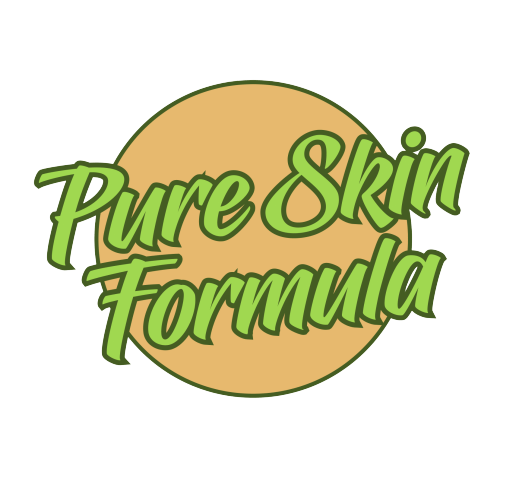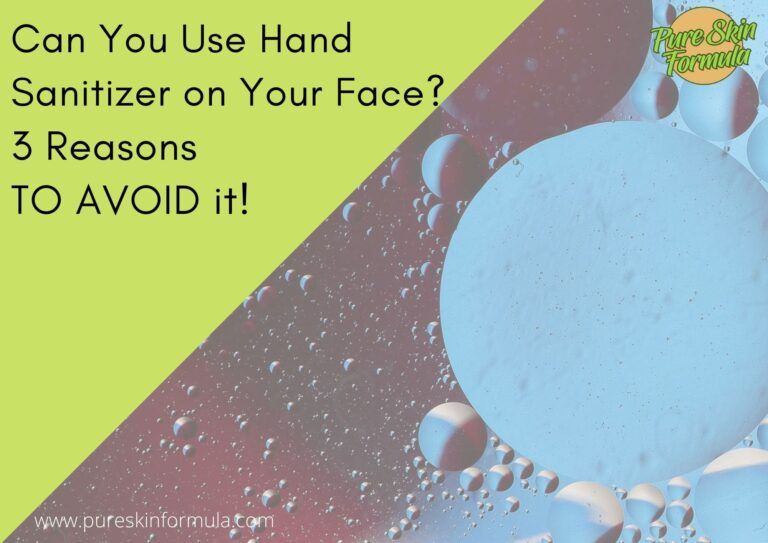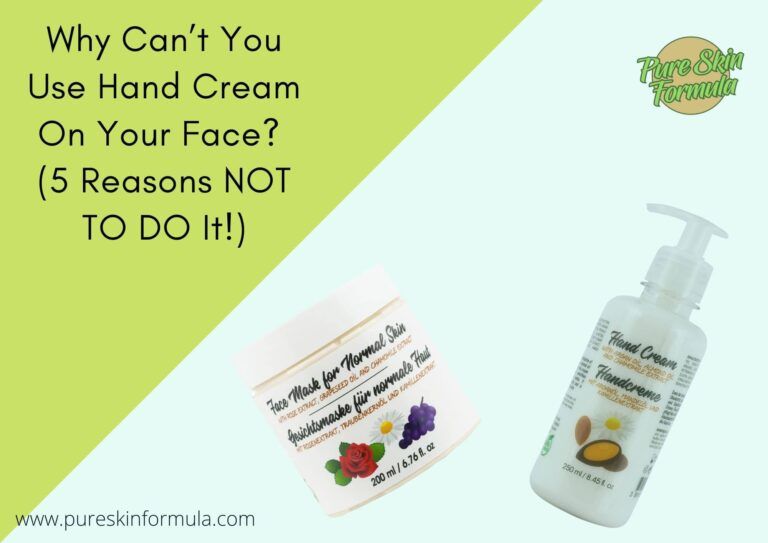Are you not sure you can use hand cream as an eye cream? The answer is pretty straightforward. You can, but this shouldn’t be your first solution. Please find below the answer to this question in full detail.
Can you use hand cream as an eye cream?
No, because:
The skin on the eyes differs from the skin of the hands
The skin around the eyes has its peculiarities. It is very thin – only 0.5mm, while the rest of the skin on the face is four times thicker.
Subcutaneous fat, sebaceous and sweat glands, and supporting fibres – elastin and collagen – are almost absent. It is, therefore, dry, sensitive and very susceptible to the formation of mimic wrinkles.

The delicate skin around the eyes is under too much strain, and for a good reason – the eye blinks about 24,000 times a day to keep up with its functions.
The skin on the palms and inside of the fingers:
- is thick with a dense stratum corneum;
- is rich in fatty and connective tissue;
- is well padded with tissue insensitive to tension;
- has no hairs and no sebaceous glands;
- has a high density of sweat glands;
- is deficient in natural moisturising factors (NMF).
A hand cream might be too thick and heavy for the area around the eyes
Indeed, there are hand cream emulsions that are thick and heavy – suitable for hands but not so appropriate for the skin under the eyes.
Avoid oily-based ones (especially if you wear contact lenses), as there is a risk of clogging the pores or damaging the lenses if they get into the eye.
Typically hand creams have a moisturizing effect, which might cause puffiness around the eyes.
The eye cream is lighter and won’t be as likely to harm the delicate skin around the eyes.
In some cases, one could use face moisturizer if it is gentle and non-irritating. They must apply it delicately due to the thin and fragile skin around the eyes.

Ideally, a hand cream and an eye cream will have natural ingredients – mostly plant oils, extracts, and kinds of butter (shea butter, avocado butter, argan oil, sesame oil, chamomile extract etc.).
What an eye cream might additionally have are, for example, components like collagen or Achillea millefolium extract, which has a surface rejuvenating effect.
The eye care product is recommended to contain gentle nourishing and hydrating ingredients (plant extracts, retinol, alpha hydroxy acids, hyaluronic acid, vitamins, collagen, coenzyme Q10) that support cellular processes and help fight wrinkles, free radicals, dark circles, puffiness.
When created professionally, the Intensive Eye Formula helps erase fine lines and wrinkles and prevents the appearance of new ones. It gives the eyes a more rested look and instantly tones the sensible eye line area.
Hand creams might contain fragrances, alcohol and other eyes’ skin irritants
Here are some ingredients that hand creams might contain but are not entirely appropriate for the skin around the eyes:
- Parabens are the most widely used preservatives in cosmetic products – they stop the growth of bacteria, fungi, and other microbes. Parabens can be related to hormone issues, fertility issues, and even breast cancer;
- Preservatives, like butylated hydroxytoluene, which is a lab-made chemical;
- Silicones, like cyclopentasiloxane.
Avoid applying cosmetics with artificial colours and dyes to the eye contour. Be especially careful about the presence of formaldehyde and hydroquinone. They can cause an allergic reaction or inflammation.
Never apply products with alcohol to the eye contour. They dry thin skin and cause redness.
Also, avoid cosmetics with perfumes and fragrances.
We know why hand cream is not the best option for the eyes.
But
How to keep the skin around the eyes fresh and young?
Prevention of problems related to the eye contour should begin from the age of 20-25 years.
The most common problems are wrinkles, “crow’s feet”, irritations and inflammations, dark circles under the eyes, “bags”, and oedema.
There are a few critical points in skincare that are extremely important, and the earlier you start with this care, the better it will affect the health and radiant appearance of the eye contour.
A balanced diet and more sleep
Consume more fresh fruits and vegetables and plant proteins such as beans, lentils, peas, and quinoa.

Dairy products are high in vitamin A, which contains retinoids that help cells regenerate faster. Avoid products that lead to dehydration, such as salt and alcohol, as the thin skin around the eyes responds remarkably quickly to water deficiency.
Proper cleaning
Cleansers should in no case contain alcohol, as it takes away from the moisture in the skin.
Do not scrub with pressure; it is best to soak a cotton pad with the solution and hold it for about 30 seconds on the eye, then, with light circular movements, remove the makeup.
Hydration and nourishing the skin around the eyes
Eye contour care products can have different textures – gel, serum, and cream. They hydrate, tone, nourish, enrich the skin, and protect it.
Proper application of the products is essential. The rule is to do it with tapping movements with the pads of the ring fingers in the direction from the inner to the outer corner of the eye.
Massage to stimulate the eyes
Delicately massaging the tension points around the eyes can improve the effectiveness of your daily decongesting ritual: do the massage in the morning before applying the eye cream to boost its efficacy.
Start with three fingers from the inner corner of the eyebrows outwards, then continue around the eyes and repeat three times.
Bonus tips on how to take care of your eyes’ skin
Below you will find even more advice on some practical steps to keep your eye contour in good shape.
Reduce puffiness around the eyes
- Apply a cool compress. You want something cool in touch, but not too cold. Lie on your back and cover your eyes with chilled tea bags or cucumber slices high in antioxidants that reduce irritation
- Soothe tired, puffy eyes with chamomile tea. Boil chamomile flowers. Strain and place the tea in the refrigerator until cold. Soak cotton pads in the tea and place them over the eyes for 15 minutes while lying down to soothe the eyes.
- Use a cool spoon. To reduce puffiness, gently massage the under-eye area with a spoon chilled in the refrigerator.
Don’t use scrubs and exfoliants
The entire body’s skin needs regular exfoliation to remove dead skin cells – from the scalp to the soles of the feet.

This applies to every millimetre of skin except for the area around the eyes. Using scrubs and exfoliants can lead to redness and even skin chapping.
Sun protection
Sunscreen is vital for the skin around the eyes as it can burn much more quickly and easily. In addition to a product with a reliable SPF, on sunny days, wear sunglasses to avoid squinting your eyes, which provokes the formation of wrinkles.
Proper intake
Keep the body hydrated – water is essential for skin elasticity.
Increase your intake of foods with skin-friendly properties – leafy greens, nuts, berries, low-fat dairy, and salmon.
Try to limit harmful habits such as smoking and alcohol. Nicotine constricts blood vessels, especially under the eyes, making it challenging to absorb needed nutrients and accelerating collagen breakdown. Alcohol dehydrates the skin, making wrinkles more noticeable.
To wrap it up!
I believe you already have a good idea of using hand cream as an eye cream.
The skin around the eyes is one of the first “victims” of the signs of ageing; with responsible adherence to proper care tips and the selection of a cosmetic product with the right combination of ingredients, it will look young and fresh for as long as possible.







